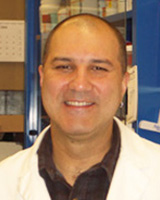Peter Chidiac

Professor
PH.D. University of Toronto
M.Sc. University of Guelph
B.Sc. University of Toronto
Office: Medical Sciences Building, Room 272
p. 519.661.3318
f. 519.661.3827
e. peter.chidiac@schulich.uwo.ca
See Publications by Peter Chidiac, and on PubMed.
Cells within an organism communicate with other cells by releasing chemical messengers, such as hormones and neurotransmitters. These bind to and activate proteins called receptors, causing changes in cell behaviour.
The majority of receptors work by promoting the binding of GTP to intracellular G proteins. Thus activated, G proteins are able to regulate effector proteins to modulate second messenger production, which in turn causes further biochemical changes within the cell.
G proteins become deactivated when the GTP bound to them is hydrolyzed to GDP. The rate of GTP hydrolysis is accelerated by RGS (regulator of G protein signaling) proteins. Thus, receptors and RGS proteins respectively activate and deactivate G proteins. Whereas the function and therapeutic importance of receptors have been studied for nearly a century, however, RGS proteins were unknown until relatively recently, and their physiological role for the most part remains to be established.
The research in my laboratory focusses on how the activities of G proteins, receptors, effectors, and RGS proteins are regulated, and how these signaling proteins interact with one another. Signaling is assessed via GTPase activity, second messenger production and biochemical changes further downstream. Additionally we study protein-protein binding, and monitor changes in protein expression and intracellular localization.
Many human diseases are characterized by deleterious G protein-mediated signals and/or treatable by drugs that are targeted to G protein pathways. In collaboration with other members of the University of Western Ontario Heart Failure Research Group, we are examining the ways in which signaling through G proteins contributes to the development of cardiac hypertrophy and heart failure, and examining how the selective attenuation of these signals might slow down the progression of this disease.








